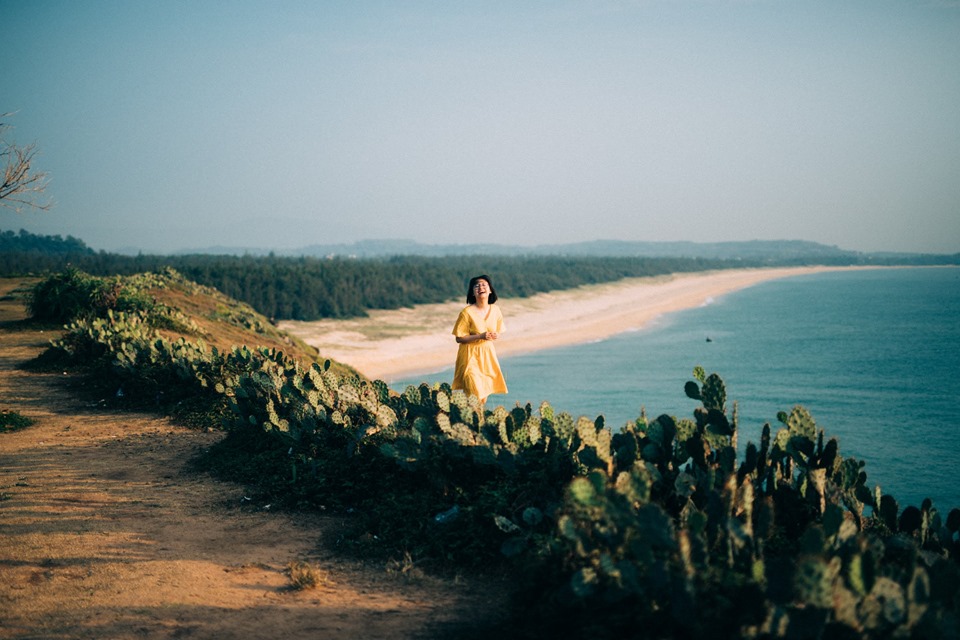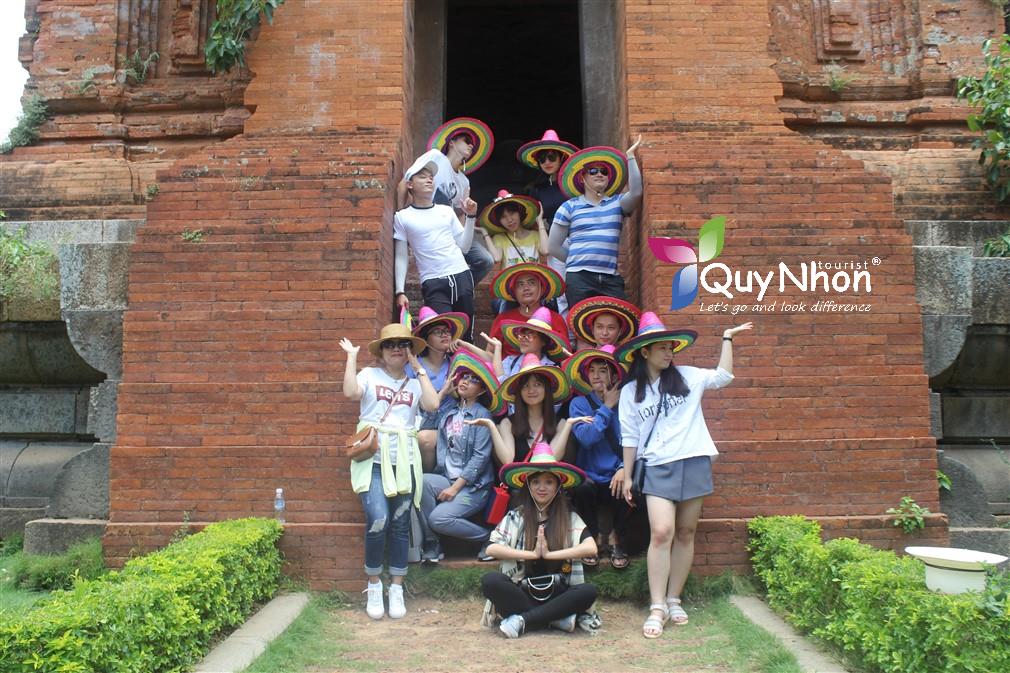BINH DINH TOURISM – The land of martial arts
25/04/2020
Binh Dinh is also famous for being the stage of glorious victories of the National Hero Quang Trung – Nguyen Hue is late 18th century, and of the local guerillas during the Resistance against the French colonialists and American imperialists in mid-20th century.
Binh Dinh is know as the cradle of the powerful martial arts of Vietnam; almost all its residents, men and women, old and young learn and master the arts by tradition; the view of a young girl perforning a few katas with bare hands or with a rod is something no visitor could spare. It is the place great poets such as Han Mac Tu, Xuan Dieu, Che Lan Vien, Yen Lan, Quach Tan,… were nurtured

1. GENERAL INFORMATION ABOUT BINH DINH
Binh Dinh is a province in the South Central coast region of Vietnam, a tropical monsoon climate area. The average temperature is 27.4°C (at highest: 39.1°C and at lowest of 15.5°C); the average moisture is 80%; and the average annual rainfall is 1.935mm (at maximum: 2647.4mm, at lowest: 1339.7mm). Binh Dinh has total natural area of 6039.56km2 and a population of over 1,500,000 people. It is bordered by Quang Ngai Province to the North, by Phu Yen Province to the South, by Gia Lai Province to the West, and by East Sea to the East; 1,065km south of Hanoi, 686km north of Ho Chi Minh City, 300km south of Da Nang City, and 300km east of Bo Y International Border Gate (in Kon Tum Province) to Laos. Binh Dinh is one of the five key economic regions of the Central Vietnam, together with Thua Thien – Hue, Da Nang, Quang Nam, and Quang Ngai.
Quy Nhon City is the cultural, economic and political center of Binh Dinh province. Quy Nhon is identified as one of international trading, service and commercial centers of both the central and Central Highlands regions.
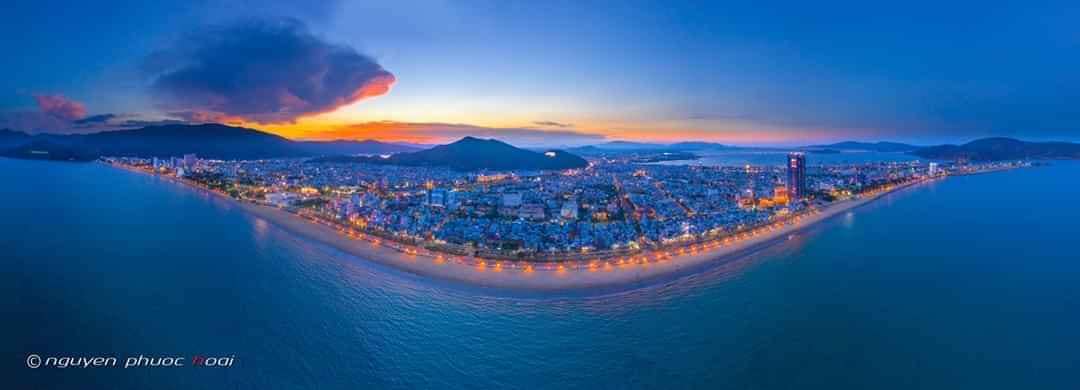
Binh Dinh is the preserve of many architectural – cultural monuments of Champa culture, especially Do Ban Citadel and the Cham towers (including 8 clusters and 14 towers) with unique architecture.
Read more: Champa ruins in Binh Dinh
Binh Dinh the ceadle of the Tay Son Peasant’s Revolution in late 18th century with the astounding glory of National Hero Nguyen Hue – Quang Trung. It is also the birthplace of many famous men and women of arts and literature such as Đào Tấn, Hàn Mặc Tử, Xuân Diệu, Chế Lan Viên, Yến Lan etc, …Several traditional art forms like traditional Vietnamese martial arts, Tuồng and Bài Chòi (performance of ancient folk song) originated from the area.

The traditional festival: Dong Da festival, Go market festival, Phuong Danh forge village festivity, Bang Chau Brass Molding village festivity, festivals at Nuoc man town and local residents, Do Gian festival etc.
Craft villages: Bàu Đá wine, wood carving, Go Sanh ceramics, horse hats of Go Gang, Phuong Danh forge village, Song Than boodle, coconut rice paper, etc…

Cuisine: rice vermicelli with pig intestines, sticky rice rolled in pinnte leaves, Bau Da wine, Song Than noodle, Huyen Market’s fermented pork, coconut rice paper, Quy Nhon fish noodle etc… and many other specialty dishes.
Binh Dinh has a long coastline of 134km and many bays with beautiful beaches plenty of scenic landscapes captivating the eyes of viewers such as: Quy Nhon, Quy Hoa, Tam Quan, Tan Thanh, Vinh Hoi, Trung Luong, Hai Giang, Yen Island, Thi Nai lagoon – Phuong Mai Peninsula, Hoang Hau beach (Queen Beach), Dai Beach (Long Beach), Dai Beach, Xep Beach etc.

Most of the accommodation in Binh Dinh is located along the beach, where there are stunning views, ensuring a good response to the demand for services of the tourists.
2. HOW TO GET TO QUY NHON – BINH DINH
Binh Dinh has a great advantage as it lies in center of transnational communications from North to South Vietnam (including roads, railway and airway communication system). It is the cloest and most convenient saport for the Tay Nguyen (Central Highlands), southern Laos, northeastern Cambodia and Thai Land (by Quy Nhon international seaport via National route 19).
Road system through Quy Nhon, Binh Dinh is crossed with national highway 1A and 1D. Highway 19, which is very convenient with the tran-provincial and interprovincial vehicle system and large amount of hight quality car and travel vans. In addition, the taxi and bus system are convenient for tourists.
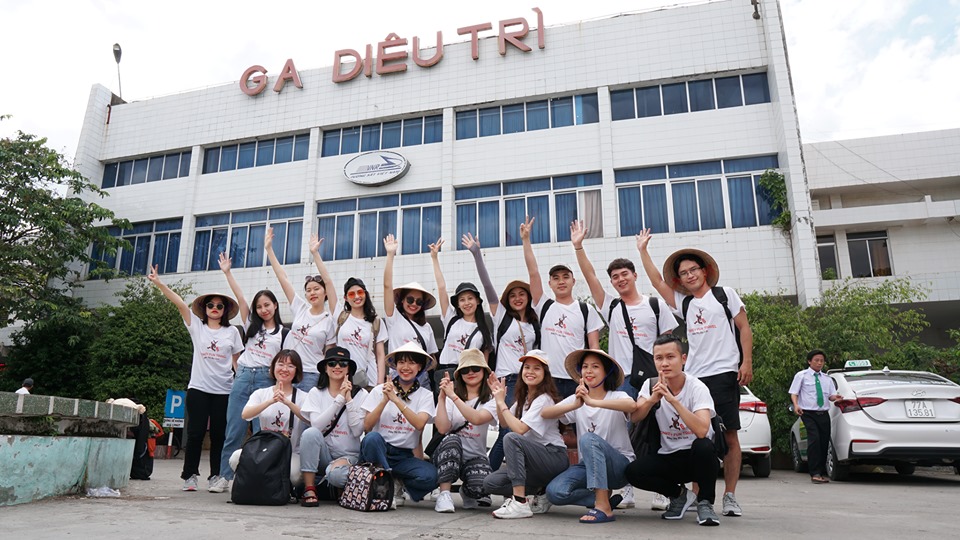
There is Dieu Tri railway station (Quy Nhon station), one of the major stations of Vietnam railway system. Train’s stoptime is over 10 minutes, and all trains from north to south do travel to Dieu tri Station (Quy Nhon).
With Phu Cat airport (Quy Nhon) 35km away from the city center, traveling between Binh Dinh and Ho Chi Minh City is very convenient and easy. Daily, ther are 05-10 daily round trip of Quy Nhon – HCM and vice versa, and 03-05 round trip between Quy Nhon and Hanoi.

3. TRADITIONAL MARTIAL ARTS OF BINH DINH
Martial arts has long been nurtured in the blood of people in Binh Dinh. This land has born may talented heroic people, including: Nguyễn Nhạc, Nguyễn Huệ, Nguyễn Lữ, Bùi Thị Xuân, Võ Văn Dũng, Trần Quang Diệu.The land of martial arts of Binh Dinh and Tay Son martial arts has contributed to various victories in the flights for national security and establishment, which has become a very own feature of Binh Dinh:
“ Let’s come to Binh Dinh to see,
The women performing martial arts”

Traditional martial arts of Binh Dinh has become a cultural heritage and a very unique beauty of local people. It has been recognized by the Ministry of Culture, sports and tourism as National Intangible Heritage in 2012. In Binh Dinh, besides watchinh performances of professional teams, visitors can tour the real martial arts training of ordinary working class in rural landmarks such as “ Thuan Truyen whip, An Thai move” or “An Thai boys, An Vinh girls” (Thuan Truyen is located in Binh Thuan commune, Tay Son, while An Vinh is in Tay Vinh – Tay Son commune and An Thai is in Nhon Phuc – An Nhon commune) or Long Phuoc pagoda (Phuoc Thuan – Tuy Phuoc). These are the cradles of traditional martial arts of Binh Dinh.
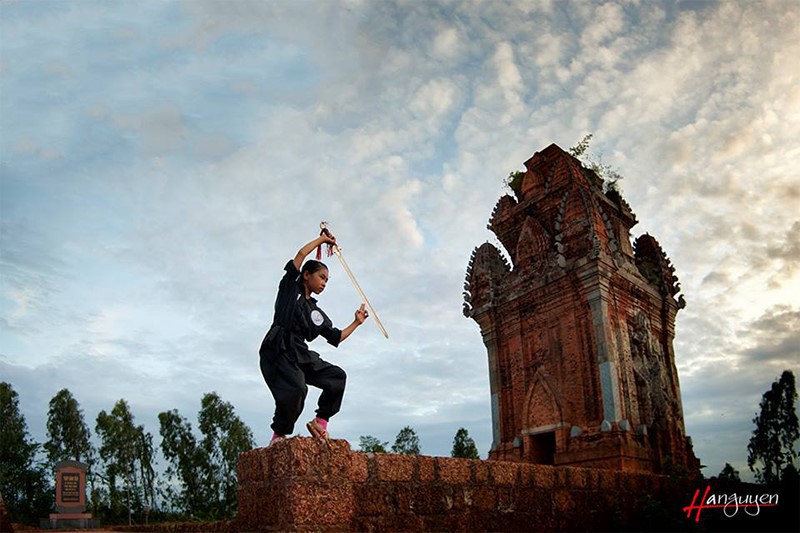
Visitors can also come to see the demonstrations of Tay Son martial at in Quang Trung Museum or other martial art schools such as Phan Tho (Binh Nghi – Tay Son), Hu Giang (Binh Thuan – Tay Son), Ly Xuan Hy (Ice dams – An Nhon), Phi Long Bay (Phuoc Son – Tuy Phuoc), etc,… to see in your own eyes the strong and flexible moves, sword performances of boys and girls of Binh Dinh. Once in every twice year, the International festival of Vietnamese traditional marital is held in Binh Dinh. This event attacts student of Vietnamese martial arts from all countries in the world to come gathering, sharing, performing researches to preserve and develop this traditional martial arts.

4. FAMOUS MARTIAL ARTS CLUB
4.1 Phan Tho Martial arts club: Master Phan Tho is the master of this martial arts club, he was born in 1928, in village 4, Binh Nghi commune, Tay Son district. At present, Phan Tho martial arts club has quite a large number of students inside and outside the province.
4.2 Ho Nganh martial arts club: Master Ho Sung is the master of this martial arts club, he was born in 1938, in Hoa My, village (from Thuan Truyen martial arts village), Binh Thuan commune, Tay Son district.

The Ho Nganh Martial arts club or Thuan Truyen martial arts village is mentioned much by the whip. The That Bo, Thai Son, Bat Quai, Tu Mon, Ngu Mon, Truc Chi, Tan Nhat, Tien Ong whip… and even Lac Con – the whip moves of master Ho Nhu (granfather of master Ho Sung) which was considered as a precious intangible cultural heritage of the traditional martial arts village Thuan Truyen is also an invaluababie asset of traditional martial arts of Binh Dinh.
4.3 Long Phuoc Tu martial arts club: Master Thich Hanh Hoa is the master of this martial arts club, he was born in 1954 the abbot of Long Phuoc pagoda in Tan Thuan commune, Tuy Phuoc district. Traditional martial arts of Long Phuoc pagoda has long been the pride of Binh Dinh martial arts and martial arts from this temple has enriched and echoes the land of Binh Dinh, Vietnam.
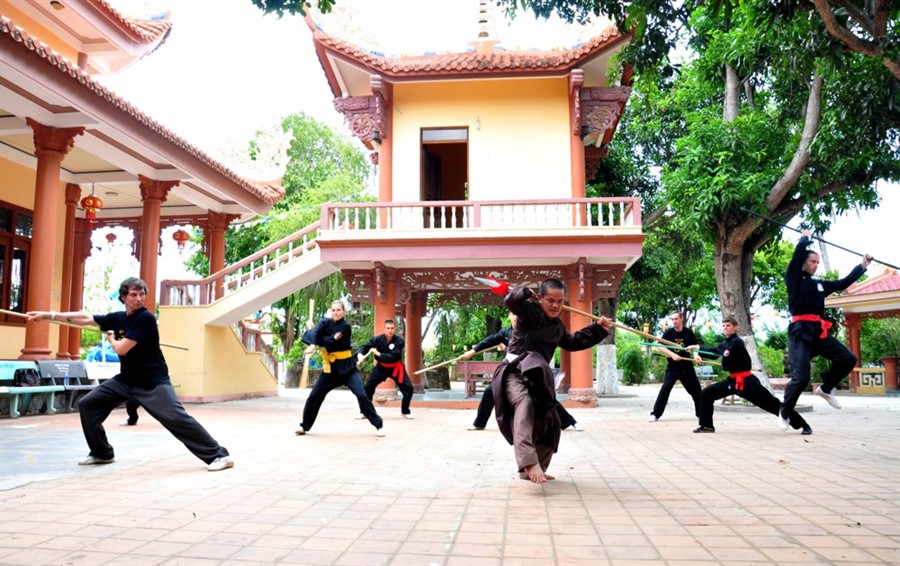
4.4 Phi Long Vinh martial arts club: Master Phi Long Vinh (Truong Van Vinh) is the master of this martial arts club, he was born in 1935, in Ky Son village, Phuoc Son commune, Tuy Phuoc district.
4.5 Le Xuan Canh martial arts club: Master Le Xuan Canh is the master of this martial arts club, he was born in 1938, in Cam Van village, Nhon Hung commune, An Nhon district. Many martial arts students of Le Xuan Canh martial arts club have learned the teachniques of Martial Arts using weapon such as Song Dao, Song Phu, Doc Kiem, Song Kich… and especially about the whip with Thai Son, Truc Chi, Bat Quai moves,… in the first generation of his students – student Bao Thuong, when he was sent to participate in the International Martial Arts Festival in Russia, was awarded with gold medal with Bat Quai whip moves. Recently, Le Xuan Canh has trained a team of athletes performing a very unique flag game in An Nhon to serve the festivals and the training of lion dance teams demonstrating martial arts in performances.

Mr Le Xuan Canh – Founder Le Xuan Canh martial arts Club
4.6 Ly Tuong martial arts club: Master Ly Xuan Hy is the master of this martial arts club, he was born in 1940, in Phuong Danh village, Dap Da town, An Nhon district. A martial arts club that has a long tradition and is famous in martial arts villages of Binh Dinh.
5. TAY SON MARTIAL MUSIC
Tay son martial music (also called Tay Son battle drum song) is a world famous unique cultural feature and also the price of the people of Binh Dinh originated from Tay Son movement in the late eighteenth century. This type of music is used to stimulate the morale of soldiers during training as well as in combat. Legend has it that Tay Son martial music played an important role in creating speedy marches and brave fights of King Quang Trung against foreign invaders.

A Tay Son martial music performance requires a set of 12 drums symbolizing 12 zodiac animals or 12 months in a year. The drums are set up into 3 rows in size order. This three rows represents the three factors: Thiên (Heaven), Địa (Earth), Nhân (People) (i.e opportunity, weaknesses and strengths, and human will). The drumers will use both hands and elbows, together with 30cm drum sticks (called “roi”), performing martial art and the drums at the same time. When he does martial art with his hands, he can hit the 4 drums at once, A battle drum song shall comprise 3 parts: committing troops to battle, blockading anemy’s city, and victory drumming. The drummers can make you feel the hard falling rain, the deliberacy, intensity as well as the excitement of the battle. Today, the Tay Son battle drumming has become a kind of ritual music in the heritage of Viet Nam.
Read more: Tay Son Tour in one day
Read more: Quy Nhon Daily Tours
(Binh Dinh Tourism Promotion Information Center)
Related news
- BINH DINH TOURISM – The land of martial arts
- Lang Song Minor Seminary (Tuy Phuoc) – Cradle of the Vietnamese language
- Champa ruins in Quy Nhon – Binh Dinh
- Eo Gio Landscape (Nhon Ly) – The most beautiful sunset view in Vietnam
- The Typical Handicraft Villages in Binh Dinh
- GHENH RANG TIEN SA – A great literati painting
- Thi Nai Lagoon, Phuong Mai Peninsula – Most diversed ecosystem in central Vietnam
- CON CHIM ECOLOGICAL ZONE – “Green Lung” of Quy Nhon City
Maybe you are interested


